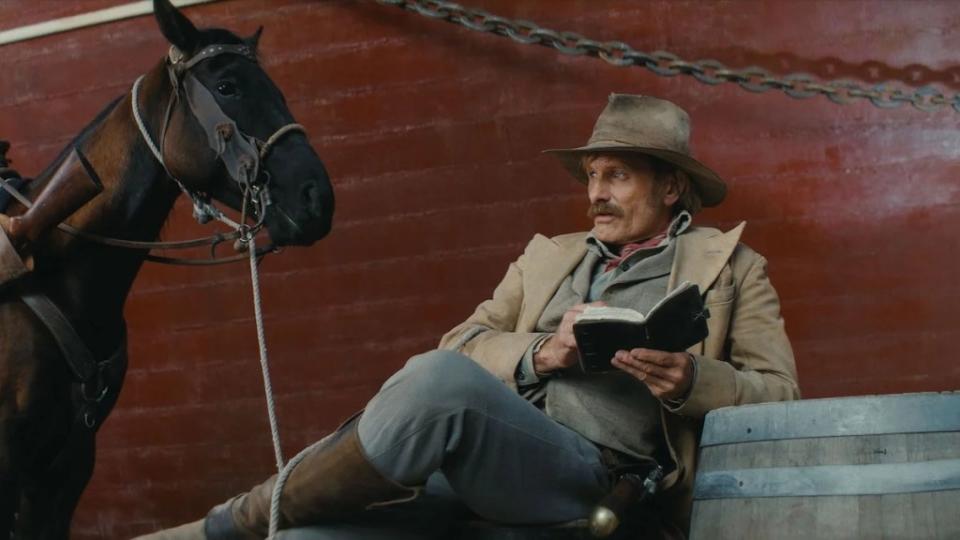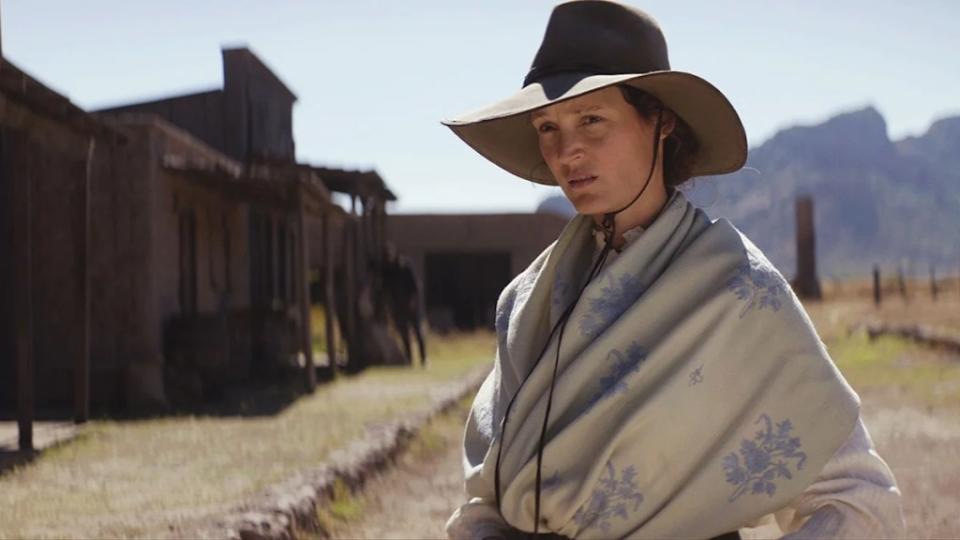Why Viggo Mortensen Put Women and Immigrants at the Center of His Western ‘The Dead Don’t Hurt’
On Friday evening in the Czech Republic, Viggo Mortensen will receive the KVIFF President’s Award at the 2024 Karlovy Vary International Film Festival, which will open with a screening of his film, “The Dead Don’t Hurt.”
The award will come less than six weeks after Kevin Costner premiered his film “Horizon: An American Saga, Chapter 1” at the Cannes Film Festival, making “The Dead Don’t Hurt” the second recent Western set in the 1860s and directed by a person better known as an actor to have a splashy European screening.
Like “Horizon,” Mortensen’s film jumps between stories — but instead of moving between different characters across a number of different territories, “The Dead Don’t Hurt” moves back and forth in time. It begins with a flurry of deaths and then backs up to tell the story of a multi-lingual Danish sheriff, Holger Olsen (Mortensen) in a small Nevada town, and a French woman, Vivienne Le Coudy (Vicky Krieps), he meets on the San Francisco waterfront and brings to live in a dusty shack that she prefers to the luxurious life she could be living with her pretentious and well-heeled beau.
TheWrap called the film “a period Western that introduces cliches only to subvert or twist them” when it premiered last fall at the Toronto International Film Festival. It had a brief U.S. release in May before Mortensen took the film to Karlovy Vary, where he joins Clive Owen, Daniel Brühl, Steven Soderbergh and Nicole Holofcener in receiving honors from the Central European festival.
“The Dead Don’t Hurt” is Mortensen’s second film as a director, after the subtle family drama “Falling,” which premiered at the Sundance Film Festival in 2020. As Mortensen told TheWrap in this unpublished conversation from Toronto, the 65-year-old actor, author, musician and filmmaker best known for the “Lord of the Rings” trilogy and for films like “A History of Violence,” “Eastern Promises” and “Captain Fantastic” is determined to make directing a career focus going forward.

You must’ve written “The Dead Don’t Hurt” during Covid, right?
I did. I had an image in my head of my mom. I have these books from her, picture books from the ’20s and ’30s. She read those as a kid, and I knew she was something of a free spirit who had a relationship with nature. I was just imagining this girl and thinking, “OK, what does this girl become? How does she become a woman?”
How did that turn into a story?
I thought I would start with the end, because then as I see characters throughout the story, I’ll know something about where they’re going. As an audience member, you’re ahead of the characters. I think that can be interesting in a novel — and when it’s done right, it can work in a movie.
I know it’s risky because some people don’t take to it, although I think there’s an appetite these days for that. But usually, I see it in series. I remember “Breaking Bad” doing that, taking time jumps. When it works, it’s great. It’s more of a risk to do it in a movie, but it can be done.
Was there any resistance to structuring the movie that way, without clear indicators when you make jumps in time?
When the actors first read the script, my question was, “Are you following what’s going on?” And when I first showed the movie, just trying it out in the editing process, I was really attentive to whether people were confused about where they were. Once nobody was, I was like, “OK, we’re there.”
Most people seem to find their way and even like it. You see a character hanged in the beginning of the story, and then you get to know him. Or you see Weston (a villainous local played by Solly McLeod) coming to visit Vivienne, and as an audience member, you know it’s not good that she’s alone with this guy. The audience is ahead of the character, and what she’s reading as politeness, we’re reading as manipulation.
As you were writing the film, was it always a Western in your head?
Not at first. The little girl I was picturing was definitely in the 19th century. And then I sort of thought, OK, what was going on in the 19th century? And when I decided to make her French-speaking, I thought about the history of the French speakers in North America and the northeast in the late 1800s. There was stuff going on between the British inhabitants and the French, and I just put that in historically. And it was a way of introducing the idea of men going off to war.
I also liked it being in that century because that’s why Westerns became interesting. They were often about the expansion westward, the opening of a frontier, and eventually the late Westerns were about closing the frontier. At this point, 1860s, it’s still a bit lawless. You don’t know what’s gonna happen.
And women and girls, no matter what their strength might be, had to adapt to a man’s world. So I thought that was a good place in which to set this story, which is essentially about a woman who’s creating new frontiers just by being herself.

Putting a woman and immigrants at the center of a Western story is a break from what you normally see in that genre.
Right. You would expect the sheriff to not have a foreign accent. And the lead woman, she could be French – that’s more or less what you saw in “Heaven’s Gate.” But for both the main characters to be clearly not native-born English speakers is unusual in the Western.
But the West was a melting pot. There were people from all over the world: Chinese, Irish, Russian, English, Welsh, French, Italians, Mexicans, Spanish, Portuguese. In the waterfront scene in San Francisco, you hear a lot of accents. And even in the town where they are, there’s a mixture of people from different places, a mixture of Mexicans and Anglos.
You’ve now directed two movies in the last four years. Are you planning to focus on directing from here?
I would love to. It’s hard to do, because you have to find someone to finance the project. If I had permission, I’d love to make a movie every year, every year and a half. But that’s unlikely. I mean, the first one took me a few years to find the money and a full year to shoot, edit and all that. Same thing with this one.
Does your directing experience make it harder for you to take roles just as an actor now?
No, I still like acting. It’s all part of that collective team effort. Being an actor, I think, is an important element. You’re on screen obviously, and it’s also what gets a movie made, depending on who’s in it. Maybe someday people will want to go see a movie just because I directed it. I don’t know. I don’t expect that that’s true yet.
I mean, if you said to me, “Would you rather act in a movie or direct a movie next?” I would say I’d rather direct. But also, at least with these first two movies I’ve directed, I’ve not really made any money – or any money that I made, I put into the production to finish it. Essentially, I either made no money or I lost money. But I got to make the movies on my own terms.
So I feel really fortunate that I can support myself going back to acting. It’s something I can do and make some money doing, sometimes. Not that I’m necessarily drawn to movies that are gonna pay really well. (Laughs) I look for good stories. Sometimes you get paid well, sometimes you don’t.
Do you see yourself directing movies that you don’t act in?
Oh, yeah. The next one, definitely. (Pauses) I mean, I said that about this one. We had an actor for six months that was paired with Vicky, and then he suddenly decided he was going to go do something else. That was not long before pre-production. I was like, “Holy s–t.”
When this guy dropped out, I tried with other actors, and it just didn’t work. We were getting to the point where we wouldn’t be able to make this movie, and I thought, Well, I could do it and that would work for the financier. So I asked Vicky, and she said, “Man, I always thought you’d be Holger.” I said, “Doesn’t the age difference bother you?” She said, “Nah.” So I put in the line where she says, “You’re too old to go to war.”
It wasn’t my intention to do it, because it’s a lot of work and it takes your focus away from the job of directing. It worked out, but I think on the next one, I wouldn’t do it.
Do you have ideas for what the next one will be?
Yeah, I have three scripts. Another one I wrote in the pandemic, and then one I’ve had for many years. And then one that someone else has that I like. It’s different from my style, but if I was allowed to write a little bit to make it more of an original movie, it’s a story I really like. And it happens to be linear, which I think would be fun.
So yeah, there’s stuff I’d like to do. There’s just this question of finding the money for it.
The post Why Viggo Mortensen Put Women and Immigrants at the Center of His Western ‘The Dead Don’t Hurt’ appeared first on TheWrap.


